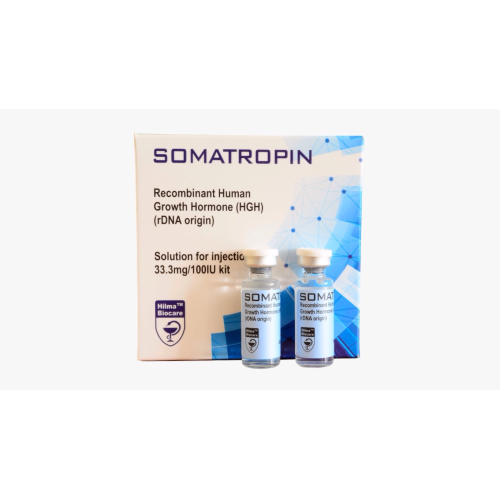Somatropin 100iu Liquid
- Brand: Hilma Biocare, Europe
- Product Code: Somatropin 100iu Liquid
- Availability: In Stock
-
$370.00
1 kit includes 2 vials containing 33.3 mg / 100 iu of Somatropin liquid.
Somatropin, similar to endogenous GH, attaches to specific dimeric GH receptors on the cell membranes of target cells, initiating intracellular signal transduction and resulting in numerous pharmacodynamic effects. Some of these effects are primarily facilitated by IGF-I produced in the liver and locally (for instance, skeletal development and protein synthesis), while others are mainly due to the direct impacts of somatropin (such as lipolysis).
In humans, growth hormone is produced by the pituitary gland. It exists at particularly high levels during adolescence, promoting tissue growth, protein deposition, and the breakdown of subcutaneous fat stores. As maturation occurs, endogenous GH levels decrease but remain present in the body at much lower levels. The actual structure of growth hormone consists of a chain of 191 amino acids. Once scientists isolated this hormone, many were convinced of its potential therapeutic benefits, particularly effective in cases of pituitary dwarfism, where the drug could potentially restore significant linear growth if given during childhood.
The use of growth hormone has gained popularity among athletes due to its associated benefits. Primarily, GH promotes growth in various body tissues, largely through increases in cell numbers rather than size. This includes skeletal muscles, while all other organs, excluding the eyes and brain, also benefit. The transport of amino acids is enhanced, as is the rate of protein synthesis, with these effects largely mediated by IGF-1 (insulin-like growth factor), a highly anabolic hormone produced in response to growth hormone (peak IGF-1 levels are observed approximately 20 hours following HGH administration).
Growth hormone itself also facilitates triglyceride hydrolysis in adipose tissue, commonly resulting in significant fat loss during treatment. It additionally boosts glucose production in the liver and induces insulin resistance by inhibiting the activity of insulin in target cells. A shift occurs where fat becomes a more primary fuel source, further enhancing body fat loss.
Its growth-promoting effects also seem to strengthen connective tissues, cartilage, and tendons, potentially reducing injury susceptibility (due to heavy weight training) and increasing lifting capacity (strength). HGH is also regarded as a safe drug in regards to the “piss-test”.
Despite its prohibition by athletic committees, there is no reliable detection method available, which explains its appeal to professional bodybuilders, strength athletes, and Olympic competitors who can use this drug continuously throughout competitions.
There are discussions, however, that a reliable test for exogenous growth hormone administration has been developed and is nearing implementation. Until that occurs, Growth hormone will remain a highly sought-after substance for tested athletes. Nevertheless, the effectiveness of HGH for athletes has been a topic of ongoing debate. Some assert that it is the holy grail of anabolic substances, capable of miraculous outcomes such as rapid muscle growth and exceptional fat loss in a short timeframe.
Because it is primarily used by serious competitors who can afford such an expensive drug, significant myths also circulate surrounding HGH discussions (often considered odd by some). Many assert confidently that the impressive physique of Olympic competitors each year is solely due to HGH use.
Conversely, others have criticized bodybuilding substances, deeming them a waste of money, ineffective as an anabolic, and only slightly beneficial for fat loss. Given its high price tag, it may be regarded as a poor investment compared to steroids. Hence, a wide array of opinions surrounds this drug; who should we believe?
Typically, a male athlete requires a dosage ranging from 4 to 6 i.u. per day to yield optimal results. On the lower end, 1 to 2 i.u. can be used daily, but this is still a significant expense. Daily administration is crucial, as HGH has a very short lifespan in the body.
Peak blood levels are commonly detected within 2 to 6 hours after injection, and the hormone is cleared from the body with a half-life of only 20 to 30 minutes. Essentially, it does not linger for long, making stable blood levels challenging to maintain. The effects of this drug are also most pronounced during longer use, often over several months.
Some individuals do utilize it for shorter durations, typically when aiming for fat loss. Therefore, a cycle of at least 4 weeks may be implemented. This compound can be delivered via both intramuscular and subcutaneous injections. “Sub-q” injections are particularly noted for producing localized fat loss, necessitating users to alternate injection sites to even out the effects. A significant reduction in fat seems to be one aspect most can agree on. It appears that the fat-burning properties of Somatropin become evident more quickly and are less reliant on high doses.

